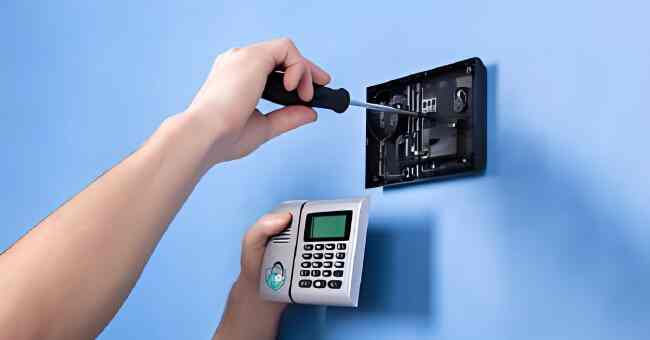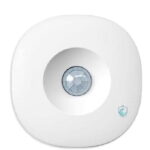Do you wish to know how to remove an alarm system? Yes, This was my question after purchasing a house that had an outdated security system installed by the previous owner.
As a first-time homeowner, I was clueless about how to safely uninstall it without triggering false alarms or damaging the property.
After some frustrating failed attempts, I knew I needed to educate myself.
I did thorough research and took careful precautions like shutting off the power and canceling the monitoring service first.
While dismantling all the outdated components took time and patience, the removal process went smoothly once I had the right knowledge.
Now I’m happy to pass on what I learned to help others upgrade their home protection the right way.
So this guide will walk you through everything you need to know to safely remove an old home security system.
I’ll cover the risks, the step-by-step process, tips for hiring a pro, what to do with the old equipment, and help you choose the best system to upgrade to.
Let’s dig in!
Dangers of Attempting Removal Without Caution
Before pulling out your toolbox, it’s crucial to understand the potential dangers of DIY security system removal:
- Electric shock – Tampering with system wiring without shutting off the power can result in serious injury. Leave electrical work to the professionals.
- Fire hazard – You can spark an electrical fire if wires are disconnected improperly. Always turn the system power off!
- False alarms – Detaching components like sensors and cameras before canceling monitoring service can trigger false alarms and lead to fines.
- Liability – Damaging property or wiring due to lack of experience could make you legally and financially responsible.
Rushing into removal without the proper knowledge puts you and your home at risk. Doing your research is the smartest first step.
Carefully Research Your Existing System
To remove your security system smoothly and safely:
- Identify the make and model – This lets you look up specific uninstall directions from the manufacturer. Check the control panel and owner’s manual.
- Locate wiring and power source – This allows you to safely shut off power before tinkering with wires. Look for the shutoff switch.
- Review monitoring contract – Check your agreement to see if professional removal is required without penalties. Call your provider to discuss.
- Inspect components – Catalog all parts like sensors, cameras, wiring so you can fully extract the system. Check for hard-to-reach spots.
- Find system diagram – This is immensely helpful for tracing wires and detaching them properly. Ask your installer or provider for this.
Doing your homework minimizes the chances of overlooking something critical in the removal process.
6 Steps To DIY On How To Remove An Alarm System
Once you’ve researched your specific system, follow these key steps to safely remove it yourself:
- Step 1: Shut Off Power to the System
- Step 2: Cancel Any Monitoring Service
- Step 3: Detach All System Components
- Step 4: Remove Wiring
- Step 5: Take Down the Control Panel
- Step 6: Delete Any System App and Codes
Shut Off Power to the System
Locate the shutoff switch for your security system and turn it off. This is usually near the control panel.
If you cannot find a dedicated shutoff, turn off power at the main circuit breaker. Double check wires with a voltmeter to ensure they are powered down before touching any cables or components.
Cancel Any Monitoring Service
Contact your security provider to terminate monitoring service. Make sure the system is fully disconnected on their end so detaching parts will not trigger false alarms.
You may need to provide notice per your contract terms (typically 30 days). There is usually a cancellation fee unless removing due to relocation.
Confirm any other contractual obligations before proceeding.
Detach All System Components
With the power off and monitoring canceled, you can start dismantling system parts. This includes:
- Keypad
- Control panel
- Motion sensors
- Door/window sensors
- Glass break detectors
- Smoke/CO detectors
- Security cameras
- Any other connected sensors or devices
Use screwdrivers to remove sensors and cameras from walls and window frames. Be careful not to damage the property as you remove hardware.
Unplug all components from power outlets as well.
Remove Wiring
Determine where system wires enter the house, typically near the control panel. Follow each wire run through the house, detaching them from baseboards, ceilings, and other mounting points.
Remove any wiring staples, clips, or fasteners to extract the cabling. Coil up wiring as you go to prevent tangling.
Pro tip: Label wires with tape as you remove them so you can identify what they power later.
Take Down the Control Panel
With all other system parts detached, you can now safely remove the main control panel. Turn off the power at the circuit breaker.
Disconnect any remaining wire connectors. Unmount the panel from the wall and ensure no wires are still attached. You may need to patch small holes left from wall anchors.
Delete Any System App and Codes
If your system had a mobile app or website, delete it from your phone or logout of the portal. This will deactivate remote access.
Also reset any system user codes or passwords related to the old system. You don’t want those left active.
With these steps complete, your old security system should be fully removed in a safe and orderly manner. Now it’s time to wrap things up.
What to Do With the Old Equipment
Once the system is dismantled, you have a few options for dealing with the leftovers:
Reuse or Resell Working Components
Some dismantled devices like sensors and cameras may still be in good working order.
You can reuse these if compatible with your new system, or try selling them on eBay/Craigslist to recoup a few bucks.
Just ensure they won’t accidentally connect to the old system.
Donate the System
Local charities, schools, or theaters may be interested in old security equipment for parts or creative projects.
You can also check if the manufacturer refurbishes and donates functioning gear. This gives the system a second life.
Recycle/Dispose of It Properly
Outdated control panels and wiring don’t have much reuse value. Best to responsibly recycle this outdated tech.
Follow local e-waste disposal regulations. Don’t just throw complex electronics in the trash!
Should You Hire a Pro?
You might prefer to hand off system removal to a professional installer or security company. Some benefits of hiring help:
- No safety risks – They are experts working with wiring and electricity.
- Proper deactivation – Prevents false alarms and fines. They know the ins-and-outs of your equipment.
- It’s faster – Professionals have the right tools and workflow to remove systems efficiently.
- More complete – Experts are meticulous and less likely to overlook components.
However, professional removal isn’t cheap. Rates range from $200 up to $1000 or more depending on the complexity of the system.
Compare this to your time and energy for a DIY removal.
Here are a few tips if you opt to hire a pro:
- Ask if they handle the full removal or just deactivate it. Ensure no remnants are left behind.
- Inquire about any disposal or recycling services they include. You don’t want to be left with a pile of old wires and sensors.
- Get an itemized estimate. Make sure optional fees for things like repairs or hauling away equipment are disclosed.
- Have them provide documentation that the system was fully removed and monitoring canceled.
Choosing Your New Home Security System
With the old system gone, the fun part is picking out an upgraded replacement! Here are key factors to consider as you shop for the latest home security:
- Your unique needs – Decide which features are must-haves like cameras, smoke detection, or home automation. Also factor in your budget.
- Wireless systems – Modern options connect components wirelessly. This provides more flexibility compared to old wired setups.
- DIY vs pro install – You can often save with easy self-installed systems, but pro install offers configuration help and labor warranty.
- Reviews and ratings – Research companies thoroughly before purchasing. Compare quality of equipment, app functionality, and customer service.
- Smart home integration – Look for a system that plays nice with smart speakers, lights, locks, and other connected tech. This expands capabilities.
Here Are The Risks Of Removing An Alarm System Without Professional Help
Removing an alarm system without professional help can pose several risks, including:
1. Electrical shock or electrocution: Working with an alarm system while it’s still connected to a power supply can be dangerous and can result in electrical shock or electrocution.
It’s important to disconnect the power supply and wait until it’s completely off before removing any components.
2. Accidentally triggering the alarm: If the alarm system is not properly disabled or put in maintenance mode, it can be accidentally triggered, causing a loud noise and potentially alerting the authorities.
3. False alarms: If the system is not properly removed, it can continue to send false alarms to the monitoring service, which can result in unnecessary emergency responses.
4. Incomplete removal: If the system is not properly removed, it can leave behind wires and other components that can be a safety hazard or an eyesore.
5. Vulnerable security: Removing an alarm system without professional help can result in a vulnerable security system.
Experts know how to install home security systems with the proper layout and design, which includes the camera positioning for video surveillance and the locations of motion sensors.
It’s important to note that if you are not experienced with home wiring, contact a professional to complete the job safely.
Additionally, never attempt to physically remove electrically charged components of a hardwired home security system without first cutting off its power supply.
Upgrading to a new system is the perfect time to reassess your family’s home security priorities. Take time to find the right solution.
The Future of Home Security Technology
Home security systems are getting smarter every year thanks to emerging technologies like:
- AI monitoring – Systems can learn normal home activity patterns and send alerts only for true abnormalities using artificial intelligence. Reduces false alarms.
- Advanced facial recognition – Cameras can use machine learning to distinguish between family, friends, strangers, and threats. Enables smarter monitoring.
- Next-gen wireless – Lightning fast 5G networks provide connectivity that enables real-time secure video streaming and other bandwidth-heavy features.
- Customization – Systems are more adaptable with easy expansion, voice control integration, and monitoring options customized for your schedule.
While removing an old alarm system can feel tedious, just remember it’s a step towards getting those exciting new home security tech innovations!
FAQs
Can You Remove A House Alarm?
Yes, you can remove an old house alarm system yourself but it takes some care and planning. The main steps are:
- Turn off power to the alarm system at the main circuit breaker
- Contact your monitoring company to cancel service
- Detach all sensors, cameras, wiring and the control panel
- Remove sensor hardware mounts/adhesive without damaging walls
- Disconnect and remove wiring
- Patch any holes or repair surfaces
- Recycle/dispose of old equipment properly
Or you can hire a security pro for $200-1000+ to handle the full removal safely and completely. But with patience and precaution, DIY removal is very doable. Just be sure to do your research first!
How Do You Remove A Home Alarm Sensor?
Alarm sensors have a few options for removal:
- Peel off adhesive sensors gently to avoid wall damage
- Unscrew sensors mounted with screws/anchors
- For wired sensors, locate where wiring exits and detach from baseboard/wall
- Remove any clips or cable ties bundling wires together
- Coil wiring neatly to prevent tangles
- Label wires with tape to identify later
Be sure to power down the system at the main circuit breaker before removing any components to avoid false alarms. Work methodically room by room to get all sensors.
What Triggers A House Alarm To Go Off?
Some main triggers that can set off a home alarm include:
- Opening a protected door or window
- Motion detected inside when system armed
- Broken glass from an intruder or accident
- Smoke or carbon monoxide detected
- A sensor failing or running low on battery
- A power outage or electrical issue
- Pressing the panic button on the keypad
Understanding sensor coverage in your home helps reduce false alarms. Also remember to disarm the system before entering!
How Do I Turn My House Alarm Off Without The Code?
If you don’t have the alarm code, you can:
- Toggle the main power switch on the control panel off/on
- Shut off power to the alarm system at the main electrical panel
- Disconnect the battery backup if it has one
- Press and hold the reset button on the control panel for 10-15 seconds
- Call your monitoring provider to have them remotely disarm it
But preventing this situation by keeping codes accessible is ideal. Never forcibly detach components which can trigger the alarm.
How Do You Remove An Alarm From The Wall?
To remove a wall-mounted alarm component like a siren or keypad:
- Power down the system at the main circuit breaker first
- Unplug any power cords or wiring connectors
- Locate screws or anchors used for wall mounting
- Use proper screwdriver to remove screws/anchors
- Gently detach unit from the wall surface
- Patch any holes and repaint if needed
Work carefully to avoid damaging the alarm component or surrounding wall area when removing.
How Do You Open An Alarm Sensor?
It’s not recommended to open alarm sensors unless necessary for repair by a technician. But if needed:
- Look for seam lines or small screws on the sensor case
- Carefully pry apart the case starting at seams using a thin tool
- Unscrew any fasteners holding the two case halves together
- Once open, you’ll see the printed circuit board and internal parts
- Make any repairs and close back up tightly to maintain waterproofing
Avoid opening sensors unnecessarily, as this can damage them or trigger false alarms.
How Long Until A House Alarm Turns Off?
Most home alarm systems will sound for a limited time, usually under 10 minutes. If the cause of the alarm isn’t resolved, the system will cycle through alarm periods and silent intervals.
Exact duration depends on monitoring service, location, and other factors.
To quickly silence the alarm, enter your user code on the keypad or disarm the system through the mobile app. Or have your monitoring provider remotely disable it.
How Long Does A House Alarm Battery Last?
For the centralized control panel, backup batteries can last 3-5 years. Individual sensors have smaller batteries that last 1-2 years on average.
System health reports can indicate components with low batteries.
To maximize battery life, ensure sensors are mounted properly to detect activity. Setting overly sensitive motion sensors to lower levels can drain batteries faster. Test sensors monthly and replace batteries as needed.
Key Takeaways for Removing an Old Security System
Removing a home security system has its challenges, but a little planning and precaution goes a long way:
- Research your specific system thoroughly so you know what to expect.
- Shut down power and cancel monitoring service first to prevent false alarms or shock risk.
- Detach all system components systematically before taking down the control panel.
- Dispose or recycle old equipment responsibly – don’t just trash it!
- Consider hiring a professional if the DIY process seems daunting.
- Take time picking out a new system with the features your family needs.
- Look forward to leveraging the latest smart home technology!
With the right approach, you can retire that outdated system and upgrade to better home protection. Here’s to smooth installations and smarter security ahead!
Conclusion
Removing an outdated home security system allows you to upgrade to better technology, but the process requires proper planning and precautions.
Remember to fully research your existing system, shut down power and disable monitoring first, detach components systematically, and dispose of old equipment responsibly.
With some diligence and patience, you can successfully usher out the old system. A professional can also handle this efficiently if you’re unsure about DIY removal.
Either way, you’ll gain peace of mind knowing your home is secured with the latest innovations in smart home security systems.





Pingback: How Do Wireless Burglar Alarms Work: 5 Steps -